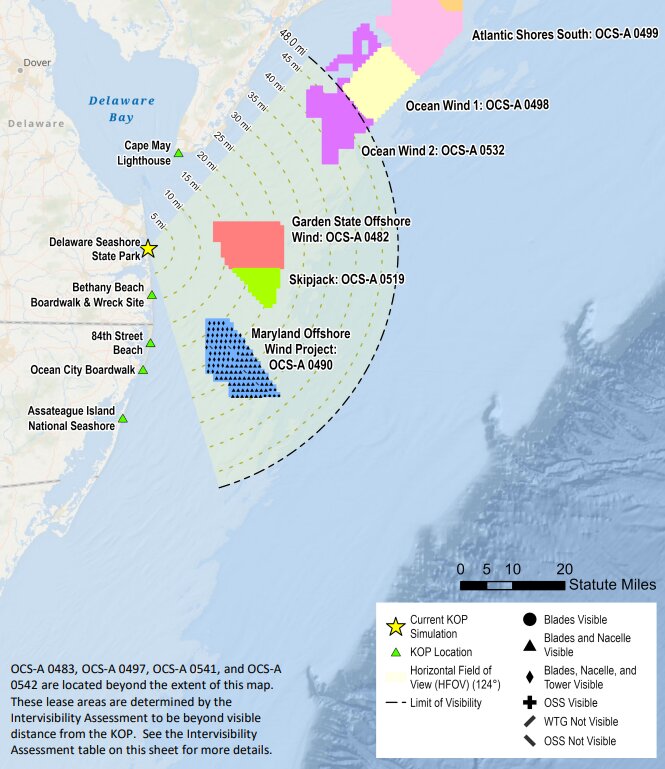Ocean bureau issues final impact statement on Maryland US Wind project
Transmission cables would make landfall in Delaware
As part of an ongoing federal review of a Maryland offshore wind project by US Wind, the Bureau of Ocean Energy Management has released its final environmental impact statement, detailing possible effects on North Atlantic right whales, commercial and recreational fishing, and coastal views.

You must be a member to read this story.
Join our family of readers for as little as $5 per month and support local, unbiased journalism.
Already a member? Log in to continue. Otherwise, follow the link below to join.
Please log in to continue |
Ocean bureau issues final impact statement on Maryland US Wind project
Transmission cables would make landfall in Delaware
DOVER — As part of an ongoing federal review of a Maryland offshore wind project by US Wind, the Bureau of Ocean Energy Management released its final environmental impact statement this week, detailing possible effects on North Atlantic right whales, commercial and recreational fishing, and coastal views.
However, in each of these realms, the agency decided the impacts are more or less in line with other current activities in the ocean.
“Our environmental review carefully considered the best available science and information provided by Tribes, other government agencies, local communities, industry, ocean users, and environmental organizations,” the bureau’s director, Elizabeth Klein, states in a news release announcing the report. “This vital collaboration with all our government partners and stakeholders will continue through the subsequent phases of the project.”
The report lists about 20 biological, physical, socioeconomic and cultural resources, and weighs five wind farm configurations against potential impacts as “negligible,” “minor,” “moderate” or “major.”
Of the five, the first option is an evaluation of past or ongoing activities. The others include the preferred alternative, as well as an alternate cable route, an option for reduced visual impact and a choice for reduced impact to habitats.
The topic of birds often comes up in wind farm conversations, and the bureau’s evaluation of bird health does include minor and moderate negative impacts to avian populations. But it also predicts minor to moderate beneficial impacts to offset those drawbacks, liking nesting areas.
The exception is doing no construction on the project at all, as this is expected to have minor negative impacts without the offset.
Another popular debate regards possible effects on marine mammals, like the North Atlantic right whale.
Including keeping things as they are, without any wind farm, BOEM expects major impacts to the whales no matter what, since issues like boat strikes and entanglement continue. Seals, dolphins and other toothed and baleen whales are all expected to suffer moderate impacts with minor benefits, both immediately and over time.
More detail is provided for whales due to marine mammal protection laws.
Among the most affected resources listed in the report are commercial and recreational fishing, which is given the range of minor to major negative impact, with opportunities for minor offsets for some for-hire fishing.
Finally, while the report says that not building the wind farm would provide only minor visual impacts to the area, all other options include major effects on visual resources.
The report considers construction, operation, maintenance and eventual decommission in its findings.
It can be found in full at permits.performance.gov/permitting-project/fast-41-covered-projects/maryland-offshore-wind-project.
If built, the project would install up to 114 turbines, up to four offshore substation platforms, one meteorological tower and a maximum of four corridors for offshore export cables, which would make landfall in Delaware Seashore State Park, north of Bethany Beach.
The lease area is off the coasts of both Maryland and Delaware, approximately 9 nautical miles from the shore.
The turbines could generate between 1,100-2,200 megawatts of electricity, enough to power more than 750,000 homes, starting in Maryland, according to the release.
“We are well on our way to putting Maryland’s offshore wind goals that much closer to reality,” states Jeff Grybowski, US Wind’s CEO, in the release. “We applaud BOEM for the comprehensive and thorough review of our federal permit application. We are now one step closer to securing all of our federal permits by the end of this year, and look forward to the day we can get steel in the water.”
The bureau also announced it will hold an offshore wind lease sale for the central Atlantic on Aug. 14, auctioning areas off of Delaware, Maryland and Virginia that could generate up to 6.3 gigawatts of clean energy and power up to 2.2 million homes.


 By
By 



